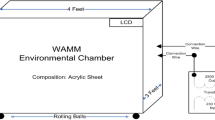Abstract
In this paper, an experimental test results on silicon rubber insulator with voltage of 20 kV have been shown. Artificial aging on insulator has been done using solid layer methods according to IEC60507 standard. Leakage current waveforms during the experimental studies were measured. Normally Fast Fourier transform method used to find the harmonic spectrum in the leakage currents. Three states of analysis are considered. In the first state, it is done with nominal voltage and without arc. In the second state, it is done in the presence of dry band arcing and corona discharge and in the last case, continuous arc is investigated and in each state harmonic analysis is performed. It is observed that in second state the third harmonic components increase rather than in the first state. Artificial aging on insulator has been done using solid layer methods according to IEC60507 standard. Leakage current waveforms during the experimental studies were measured. Eventually, to distinguishing pollution intensity, equivalent salt deposit density calculations are implemented. At the end, finite element method has been investigated for the results of water droplets existing on the surface of silicone rubber materials and electric field distribution along the surface of insulator.





















Similar content being viewed by others
References
Seifert JM, Hubl W (2001) Hydrophobicity effect of silicone housed composite insulators and its transfer to pollution layers–design and environmental parameters influencing the hydrophobic surface behavior. Iraklion symposium, Kreta (26 and 27th April)
Deng H, Cherney EA, Hackam R (1993) Effects of particles size of ATH fillers on the performance of RTV rubber coatings. In: IEEE electrical insulation and dielectric phenomena conference, pp 598–604
Liu Y, Wang JK (2002) Analysis of large area pollution flashover occurred in Shannxi power network on Dec. 18, 2000 and preventative measures for similar accidents. Power Syst Technol 26:82–85
Otsubo M, Hashiguchi T, Honda C, Takenouchi O, Sakoda T, Hashimoto Y (2003) Evaluation of insulation performance of polymeric surface using a novel separation technique of leakage current. IEEE Trans Dielectr Electr Insul 10(6)
Wang T, Ou QH, Wu JH (2004) Test and research on cleaning of high voltage transmission line based on salt density. Power Syst Technol 28:22–26
Manabe Y (1996) New measuring equipment of ESDD of transmission line insulators. In: Proeedings of joint conference Asian international conference on dielectrics and electrical 96‘AICDEl and 4th-JCCEID Xi’an
Kaana S, Nkusi PH (1988) Potential and electric field distributions at a high voltage insulator shed. IEEE Trans Electr Insul 23(2)
Kojimi S, Oyama M, Yamashita M (1988) Potential distribution of metal oxide surge arresters under various environmental conditions. IEEE Trans Power Deliv 3(3):984–989
Subba Reddy B, Kumar A, Shashikala A, Ravishankar KV (2009) Electric field modeling of composite high voltage insulators, India. In: IEEE annual conference (INDICON)
Que W, Sebo SA (2002) Typical cases of electric field and voltage distribution calculations along polymer insulators under various wet surface conditions. In: Annual report conference on electrical insulation and dielectric phenomena
IEC 60507 (1991) Artificial pollution tests on high-voltage insulators to be used on AC systems. International Electrotechnical Commission, Geneva
Bologna FF, Reynders JP, Britten AC (2003) Corona discharge activity on a string of glass cap-and-pin insulators under conditions of light wetting, light non-uniform contamination. In: IEEE Bologna PowerTech Conference, Bologna June, pp 23–26
Phillips AJ, Childs DJ, Schneider HM (1999) Aging of non-ceramic insulators due to corona from water drops. IEEE Trans Power Deliv 14(3):1081–1086
EPRI (1998) Application guide for transmission line NCI. Palo Alto, TR, pp 111–566
Author information
Authors and Affiliations
Corresponding author
Rights and permissions
About this article
Cite this article
Joneidi, I.A., Kamarposhti, M.A., Shayegani Akmal, A.A. et al. Leakage current analysis, FFT calculation and electric field distribution under water droplet on polluted silicon rubber insulator. Electr Eng 95, 315–323 (2013). https://doi.org/10.1007/s00202-012-0260-8
Received:
Accepted:
Published:
Issue Date:
DOI: https://doi.org/10.1007/s00202-012-0260-8




